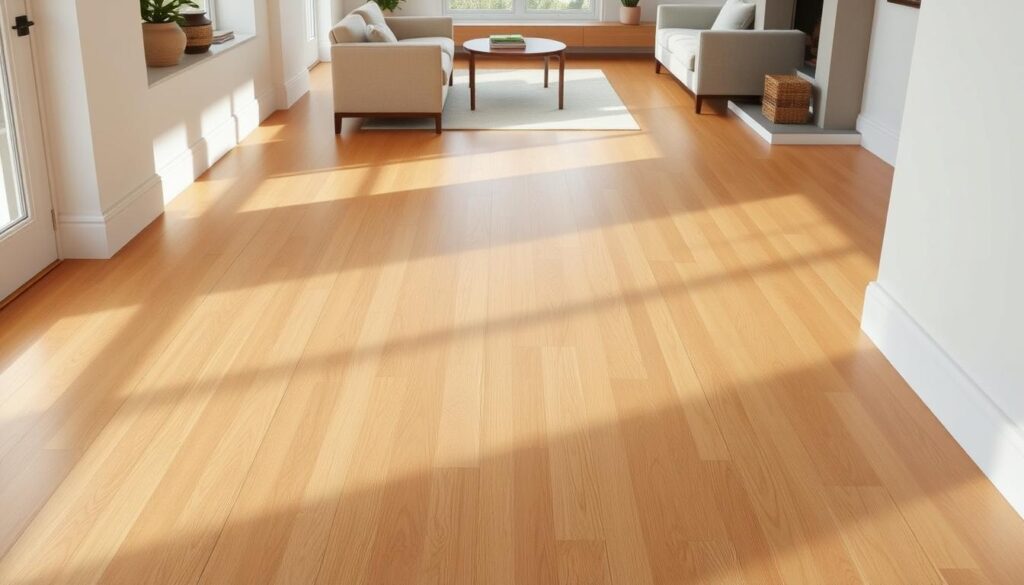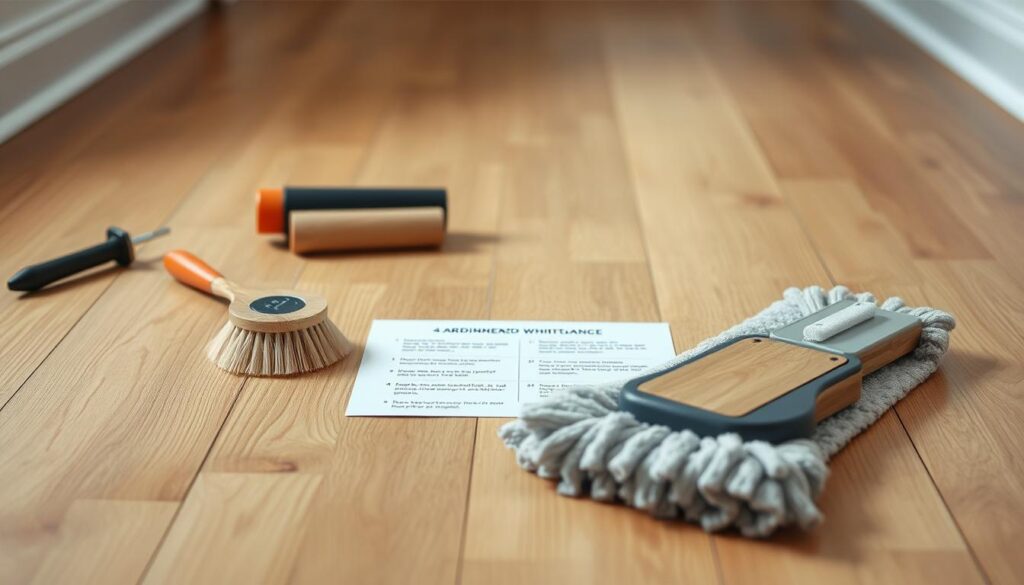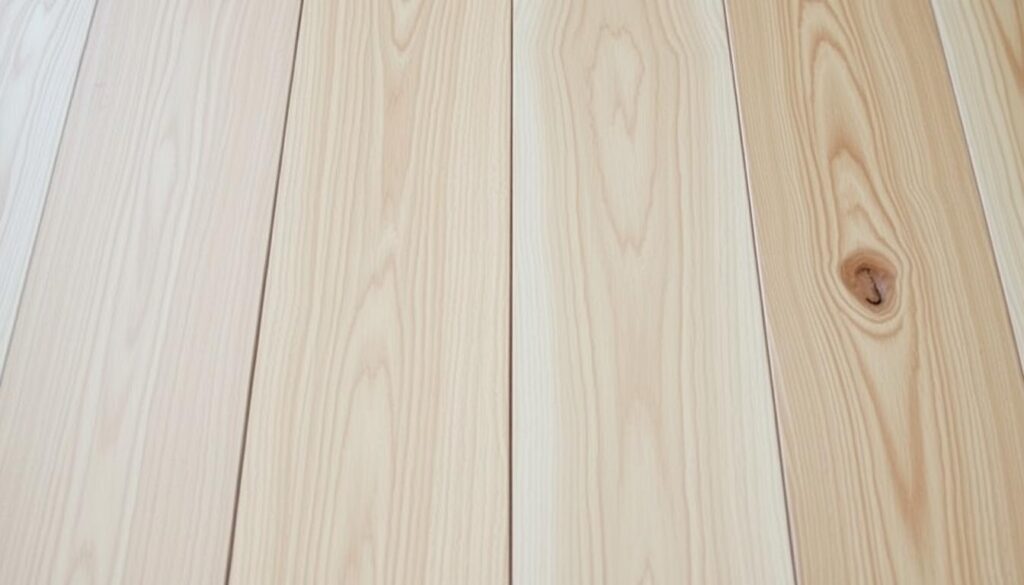Discover the benefits of 4 inch white oak flooring. Our listicle covers key considerations, installation tips, and more.
4 inch white oak flooring is a stylish and durable choice. It’s perfect for both modern and traditional homes. The mid-sized plank width is ideal, offering a balance that suits any space.
White oak floors are known for their natural strength and beautiful grain patterns. They are a favorite in American homes for their beauty and durability.

Choosing the right plank size is important. At 4 inches, these floors look great without feeling too cramped or too wide. White oak’s dense grain also helps it resist scratches, making it perfect for busy areas.
This article will help you understand the cost, design, and maintenance of white oak floors. It aims to guide you in picking the best hardwood flooring for your home.
Key Takeaways
- 4-inch planks offer flexibility for various room sizes and styles.
- White oak’s durability makes it ideal for active households.
- Plank width impacts a room’s visual flow and comfort.
- Investing in 4-inch white oak flooring balances aesthetics and practicality.
- Proper maintenance extends the lifespan of white oak floors.
Why 4 Inch White Oak Flooring Is a Popular Choice
4-inch white oak flooring is a favorite in many homes. It’s loved for its flexibility, balanced look, and ability to handle different climates. These qualities make it a great choice for those who want both beauty and function.
Timeless Appeal and Versatility
As a versatile flooring option, 4-inch planks fit well with many styles. They look good in:
- Traditional homes with classic moldings
- Modern lofts with minimalist decor
- Rustic spaces with natural finishes
This flexibility lets homeowners update their spaces without losing durability or style.
The Perfect Middle Ground
| Plank Width | Best For | Common Challenges |
|---|---|---|
| Narrow (2-3″) | Small rooms | Can create busy patterns |
| 4″ White Oak | All room sizes | Optimal balance |
| Wide (5-7″) | Large open spaces | Risk of overwhelming smaller areas |
This width is just right, avoiding the mess of narrow planks but still looking elegant.
Superior Stability in Varying Climates
White oak’s natural stable hardwood flooring properties resist warping and swelling. It stays strong in humid or dry climates. This makes it perfect for busy areas like kitchens and basements.
The Unique Benefits of White Oak as a Flooring Material
White oak hardwood is known for its top-notch performance in flooring. It has a Janka hardness rating of 1,360. This means it can withstand dents and scratches well, making it a favorite for durable wood flooring.
Video source from youtube
When comparing white oak to red oak, some key differences are clear. White oak’s closed cellular structure is better at blocking moisture than red oak’s open pores. This makes kitchens and entries safer from spills, reducing the need for extra protective layers.
Its grain pattern is smoother, offering a sleeker look compared to red oak’s bold texture.
Natural light brown to beige tones form a neutral backdrop for any design. White oak accepts stains evenly, whether using water-based or oil-based finishes. This adaptability lets homeowners customize colors without worrying about uneven absorption.
Over time, its natural resistance to insects and rot ensures longevity, adding value to any home.
With its timeless appeal, white oak flooring is a versatile, long-lasting solution. Homeowners gain both beauty and durability in every plank.
Understanding the Cost Factors of 4 Inch White Oak Flooring
Exploring the cost of white oak flooring begins with its material and labor costs. This part explains how these costs fit into the overall value of your flooring investment.
Initial Purchase Price Range
The cost of 4-inch white oak flooring varies from $5 to $12 per square foot. These white oak flooring cost changes come from:
- Grade: Select-grade planks are more expensive than rustic or character ones
- Finish: Prefinished planks cost $1–$3 more per square foot than unfinished ones
- Sourcing: Domestic products are 15–20% pricier than imported ones
Installation Cost Considerations
Professional hardwood installation expenses usually range from $3 to $7 per square foot. Key factors affecting costs include:
- Subfloor repairs adding $0.50–$2 per square foot
- Underlayment and transitions requiring $0.75–$1.50 extra per square foot
Long-term Value Assessment
White oak’s durability means long-term savings. Its flooring investment value surpasses many other options:
| Material | Cost Range | Lifespan |
|---|---|---|
| White Oak | $5–$12/sq ft | 50+ years |
| Engineered Wood | $4–$10/sq ft | 20–30 years |
| Laminate | $2–$8/sq ft | 10–15 years |
Although it costs more upfront, white oak lasts longer. This means you won’t need to replace it as often as with shorter-lived materials.
Installation Methods for 4 Inch White Oak Planks
Proper hardwood floor installation makes 4-inch white oak flooring last for decades. The nail down flooring method is best for solid planks. It secures boards to a wooden subfloor with finishing nails. This method creates a strong, durable base, perfect for busy areas.
For concrete subfloors or engineered planks, other options are available. Floating floor installation uses a tongue-and-groove system without nails or adhesives. It’s lighter and easier for DIY projects. Glue-down methods attach planks with adhesive, great for concrete when moisture is a concern.
| Method | Best For | Key Features |
|---|---|---|
| Nail-Down | Solid planks on wooden subfloors | Stable, long-lasting, requires professional tools |
| Floating | Engineered planks | Easy to install, no subfloor fastening |
| Glue-Down | Concrete subfloors | Moisture-resistant adhesives, smooth subfloor needed |
Installation needs careful attention. Let planks acclimate for 5–7 days before starting. Keep 1/4–3/8 inch gaps around walls for moisture. Use staggered patterns and random spacing of at least 4 inches to avoid repetition.
“Expansion gaps and proper acclimation are non-negotiable. Skipping these steps leads to warping.”
Professionals are best for nail-down methods due to the tools needed. Floating floors might be DIY-friendly for those with experience. Always follow the manufacturer’s guidelines for subfloor prep and installation techniques.
Design Possibilities with 4 Inch White Oak Flooring
White oak floor designs are incredibly versatile. They fit perfectly in both old and new homes. This material lets homeowners create a beautiful interior design that matches current trends.
Traditional Room Applications
Four-inch planks are perfect for traditional homes like colonial or Craftsman styles. They look great with old furniture and decor. These floors bring timeless beauty to any room, keeping it modern.
Contemporary Design Integration
In modern homes, white oak can be styled in many ways. Light stains give a Scandinavian feel, while dark stains add an industrial touch. Matte finishes make rooms feel softer, and glossy finishes reflect light in open spaces.
Pattern Options and Visual Effects
Try out different hardwood flooring patterns easily:
- Herringbone: Zigzag patterns add elegance to dining rooms
- Chevron: Diagonal lines make spaces like gyms or game rooms lively
- Border accents: Use them to highlight entryways or divide open areas
These patterns add depth and are easy to install, unlike narrower planks.
Whether it’s a bright kitchen or a cozy study, 4-inch white oak is both stylish and practical. Each pattern choice shows off your personal style while staying on trend with home design.
Maintenance Requirements and Best Practices

Keeping 4-inch white oak floors in top shape requires regular hardwood floor maintenance. Start by sweeping daily with a soft broom or microfiber dust mop. This helps remove dirt that can scratch the surface.
For weekly cleaning, mix pH-neutral cleaners with water. Make sure to avoid using too much water. Dry the floor right away after spills to prevent warping.
- Spot clean stains with a damp cloth. Never use ammonia or vinegar, which damage finishes.
- Use felt pads under furniture legs to prevent dents. Rotate rugs yearly to avoid uneven wear.
Keeping humidity levels right is key for preserving hardwood flooring. Use a dehumidifier in summer and a humidifier in winter. This keeps the humidity between 35–55%. In the US, changing seasons mean you need to check your floors often to prevent gaps or buckling.
| Finish Type | Cleaning Tips |
|---|---|
| Polyurethane | Avoid wet mopping; use dry maintenance |
| Oil-Based | Reapply finish every 3–5 years |
| Water-Based | Quick drying—use for high-traffic areas |
| UV-Cured | Resistant to scratches; recoat if scuffed |
To fix scratches, lightly sand with 220-grit sandpaper and then buff. For deeper damage, you might need to refinish every 7–10 years. Always follow the manufacturer’s advice for cleaning white oak floors to keep them looking great for years.
How 4 Inch White Oak Flooring Compares to Other Widths
Choosing the right plank width for your home is all about finding the perfect mix of style and function. Let’s dive into how 4-inch planks compare to other options.
Compared to narrower planks, 4-inch boards find a sweet spot. They don’t make spaces feel too long like 2-3 inch planks do. But, they also don’t have the same busy look as those narrower options.
Installing 4-inch planks requires more pieces and materials. This can increase labor costs. However, they are less likely to warp in stable climates. But, in humid areas, they might show gaps.
| Feature | 4-inch Planks | 5-7 inch Planks |
|---|---|---|
| Visual Impact | Balanced modern-traditional look | Grand, rustic, or open spaces |
| Expansion Risks | Moderate movement with climate | Higher risk of warping/gapping |
| Cost | Mid-range pricing | Higher per sq. ft. due to wider material |
- Choose 4-inch for:
- Cheerful kitchens or dining rooms needing durability without overwhelming space
- Regional climates with humidity swings (Midwest, Southeast)
- Budget-conscious buyers seeking value over extreme widths
Mid-sized rooms like living areas are perfect for 4-inch planks. They offer a balance that avoids the look of narrow strips and the cost of wide planks. This makes them a great choice for many American homes.
Selecting the Right Finish for Your White Oak Floors
Choosing the right finish is key to keeping your white oak floors looking great and lasting long. White oak floor finishes come in two types: site-finished and prefinished. Site-finished options let you customize but take longer to dry. Prefinished planks are quicker to install but offer less flexibility.

- Oil-based polyurethane: Durable but high VOC content
- Water-based polyurethane: Eco-friendly, quick-drying
- UV-cured finishes: Industrial-grade, scratch-resistant
- Hard-wax oils: Natural look, low maintenance
| Finish Type | Pros | Cons |
|---|---|---|
| Oil-based polyurethane | Deep penetration, rich color | Strong odor, longer cure time |
| Water-based polyurethane | Low odor, eco-certified | Less resistance to heavy traffic |
| Hard-wax oil | Easy recoating, enhances grain | Requires regular maintenance |
Hardwood staining options depend on white oak’s natural light tones. Light stains like whitewash highlight the grain, while darker stains add warmth. Protective floor coatings like UV-cured systems are ideal for high-traffic areas. Modern trends favor matte and satin sheens for a modern look, though high-gloss remains popular in formal spaces.
Regional preferences vary: coastal areas often opt for water-resistant finishes, while urban homes may prioritize low-VOC options. Always check curing times to align with your project timeline, and confirm VOC levels meet local building codes. The right finish balances aesthetics, lifestyle, and long-term care needs.
Environmental and Sustainability Aspects
Choosing eco-friendly flooring like 4-inch white oak is more than just looks. It affects forests and our homes.
Forestry Practices for White Oak Sourcing
Responsible forestry makes sure white oak stays available. North American forests grow white oak for 50–80 years. They balance cutting down trees with replanting.
Buying wood from the U.S. often means less carbon emissions. This is because it avoids unclear practices found in imported wood.
- Domestic forests: Regulated thinning and replanting programs
- Harvesting: Selective cutting to preserve ecosystem diversity
- Imported wood: Risk of non-sustainable practices
Certifications to Look For
Third-party certifications show if wood is harvested sustainably. Look for these labels when buying eco-friendly flooring:
| Certification | Description | Verification |
|---|---|---|
| FSC | Forest Stewardship Council ensures forests are managed to protect wildlife and workers | Check FSC labels and certificates on product packaging |
| SFI | Sustainable Forestry Initiative promotes responsible harvesting in North America | Search SFI’s public database using product codes |
| PEFC | Programme for Endorsement of Forest Certification verifies chain-of-custody tracking | Verify via PEFC’s certification numbers |
Indoor Air Quality Considerations
Low VOC wood floors mean less chemical exposure. Finishes and adhesives can release harmful fumes if not treated right. Look for:
- FloorScore certification: Confirms compliance with indoor air quality standards
- GOLD GREENGUARD certification: Guarantees low chemical emissions
- Water-based finishes: Lower VOC content than oil-based alternatives
Properly finished sustainable hardwood floors meet both environmental and health goals.
Common Challenges and Solutions When Installing 4 Inch White Oak Flooring
Proper wood floor acclimation is key to avoid hardwood installation problems. Not letting planks adjust to room humidity and temperature can cause warping or gaps. Place boxes of flooring flat in the room for 48–72 hours before installation. Stack planks loosely to allow even acclimation.
Subfloor issues are a big problem in flooring troubleshooting. Make sure subfloors are clean, dry, and level. Use self-leveling compounds for dips or gaps wider than 1/8 inch. Sweep debris and check moisture levels with a meter—readings under 12% are ideal.
Common errors during 4-inch plank installation include:
- Ignoring expansion gaps near walls and fixtures
- Overscrewing nail-down systems or overgluing floating floors
- Forcing boards to fit, creating misalignment
When transitioning to tile, carpet, or other flooring, use reducer strips or custom cuts. Pre-drill pilot holes near doorways to avoid splitting. Post-installation flooring troubleshooting often addresses squeaks (caused by loose fasteners) and cupping (linked to moisture imbalance). Re-tighten fasteners and use a dehumidifier if humidity exceeds 50%.
Professional installers suggest staggered board patterns to minimize visual repetition of grain. For color variations, mix planks from multiple boxes during layout. Always leave ⅛-inch space between walls for expansion to prevent buckling.
Conclusion: Making the Right Choice for Your Home
Choosing 4-inch white oak for your floors is a smart move. It looks great in any room and lasts long in busy areas. This wood is stable, so it won’t warp much, even in changing weather.
It’s a good choice if you want your floors to look good and work well. It’s not too thin or too wide. It’s just right for a modern or classic look.
When picking wood floors, think about your budget, how much you like to clean, and if you care about the environment. White oak costs more upfront but saves money in the long run because it lasts longer. Look for FSC certifications and low-VOC finishes for better air quality.
For homes in humid places, narrower planks might be better. But for bigger rooms, 4-inch planks add a clean, modern touch.
In the end, 4-inch white oak is a great choice for many homes. If you value durability, flexibility, and beauty, it’s a good pick. Compare it with other options carefully. The best choice depends on what you need for your home now and in the future.
FAQ
What is the average cost of 4 inch white oak flooring?
The cost of 4 inch white oak flooring is usually between $5 and $12 per square foot. This price can change based on the quality, finish, and where the wood comes from.
How does 4 inch white oak flooring compare to other plank widths?
4 inch planks are a good choice because they are not too thin or too wide. They look good and are stable, making rooms feel less crowded.
What are the installation options for 4 inch white oak flooring?
You can install 4 inch white oak flooring in a few ways. For solid planks, nail-down is best. For engineered planks, glue-down or floating are better. Each method needs a different subfloor and has its own challenges.
How can I maintain my 4 inch white oak flooring?
Keep your flooring clean with pH-neutral cleaners and dust often. Use furniture pads to protect it. Clean deeply once a week and refinish every 7-10 years, depending on how much it wears.
What type of finish is best for white oak flooring?
You can choose from oil-based, water-based polyurethanes, UV-cured finishes, or natural oils. Each finish affects how long it lasts and how it looks. Pick based on how shiny you want it and how easy you want it to be to clean.
Is white oak environmentally friendly?
Yes, white oak can be good for the environment if it comes from well-managed forests. Look for FSC or SFI certifications to make sure it’s sustainably sourced.
Can I install 4 inch white oak flooring myself?
You can try installing it yourself, but it’s often better to hire a pro. Getting the subfloor right and installing correctly are key to making it last.
What design styles work best with 4 inch white oak flooring?
4 inch white oak flooring fits many styles, from old to new. It works well with both classic and modern looks, making it versatile for many decorating choices.
How does seasonal humidity affect 4 inch white oak flooring?
4 inch white oak flooring is stable in different climates. But, make sure to leave room for it to expand and control humidity to avoid problems like cupping or gapping.
What are the common challenges when installing 4 inch white oak flooring?
Installing can be tricky due to issues like not acclimating properly, uneven subfloors, and alignment problems. Following the right steps is key to a successful and lasting installation.
Read also : Discover the Benefits of Select White Oak Flooring Today
